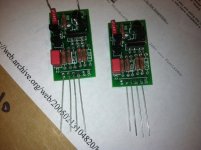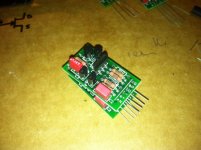I'm sure about that 😉 Having all poles placed on the same circle and equally spaced, in the s-plane, is caracteristic of the Butterworth alignment.
Hi Bricolo,
1 pole Butterworth use Q=0.7071
2 pole Butterworth use Q=0.7071
3 pole Butterworth use Q=1 & Q=0.7071
4 pole Butterworth use Q=1.3066 & Q=0.5412
L-R2 use cascade Q=0.7071 ( 2*B1 )
L-R4 use cascade Q=0.7071 ( 2*B2 )
L-R6 use cascade Q=1 & Q=0.7071 ( 2*B3 )
L-R8 use cascade Q=1.3066 & Q=0.5412 ( 2*B4 )
As you said, all these filters are set at the same Xover frequency.
Do you need the gain settings to achieve these Q values?
Have you read LeCleach on xover modification yet?http://freerider.dyndns.org/anlage/LeCleach2.zip Then you have to change frequencies.
Can this mod be modelled on Moxlite?
Has anyone listened to this mod yet?
1 pole Butterworth use Q=0.7071
2 pole Butterworth use Q=0.7071
3 pole Butterworth use Q=1 & Q=0.7071
4 pole Butterworth use Q=1.3066 & Q=0.5412
L-R2 use cascade Q=0.7071 ( 2*B1 )
L-R4 use cascade Q=0.7071 ( 2*B2 )
L-R6 use cascade Q=1 & Q=0.7071 ( 2*B3 )
L-R8 use cascade Q=1.3066 & Q=0.5412 ( 2*B4 )
As you said, all these filters are set at the same Xover frequency.
Do you need the gain settings to achieve these Q values?
Have you read LeCleach on xover modification yet?http://freerider.dyndns.org/anlage/LeCleach2.zip Then you have to change frequencies.
Can this mod be modelled on Moxlite?
Has anyone listened to this mod yet?
For a first order filter, the Q does not apply.
Q can only be defined for a second order function.
\Jens
Q can only be defined for a second order function.
\Jens
Hi Bricolo,
would you like to start a new thread (or wiki) & explain that poles, circles & s-plane theory? and how to use it in practice.
I would like to learn more.
would you like to start a new thread (or wiki) & explain that poles, circles & s-plane theory? and how to use it in practice.
I would like to learn more.
Hi,
It's not very usefull to set up an audio filter, since everything is already pre-calculated and many tables are available.
But if you want to have a deeper look at the theory, and where those tables come from, you can read those pages:
Do you know what a s-plane is? Basicly, it's a map where your poles and zeros are placed, according to theyr Real and Imaginary part.
This chapter seems good
http://www.phys.ualberta.ca/~gingrich/phys395/notes/node38.html#SECTION00400000000000000000
And for Butterworth filters:
http://www.microindustrie.com/dsp/b-dis.htm
It's not very usefull to set up an audio filter, since everything is already pre-calculated and many tables are available.
But if you want to have a deeper look at the theory, and where those tables come from, you can read those pages:
Do you know what a s-plane is? Basicly, it's a map where your poles and zeros are placed, according to theyr Real and Imaginary part.
This chapter seems good
http://www.phys.ualberta.ca/~gingrich/phys395/notes/node38.html#SECTION00400000000000000000
And for Butterworth filters:
http://www.microindustrie.com/dsp/b-dis.htm
Tables are always normalized to a frequency, when using tables to design a filter, you also should look up frequency scaling as this is needed to calculate the parameters in the non normalized filter.
Frequency scaling "moves" the corner-freq from the normalized frequency to where you want your filter to have it's cornerfrequency.
I hope I make sence
\Jens
Frequency scaling "moves" the corner-freq from the normalized frequency to where you want your filter to have it's cornerfrequency.
I hope I make sence

\Jens
Butterworth 4 pole
Hi all,
I have attached an excel spreadsheet to calculate the caps & resistors for a 4 pole low pass filter.
It uses 2 cascaded unity gain stages (moxlite) with staggered Qs of .54 & 1.3 to achieve a total q=0.7071 for Butterworth roll off.
Each stage could be used for odd values of Q if Mox shows the need to tailor the Xover to your speakers.
Hi all,
I have attached an excel spreadsheet to calculate the caps & resistors for a 4 pole low pass filter.
It uses 2 cascaded unity gain stages (moxlite) with staggered Qs of .54 & 1.3 to achieve a total q=0.7071 for Butterworth roll off.
Each stage could be used for odd values of Q if Mox shows the need to tailor the Xover to your speakers.
Attachments
Does anyone have a copy of the MOX II opamp assembly guide? Referenced in post #4.
Thanks,
Vince
Thanks,
Vince
Anyone have a better photo shot on how to mount the headers? They appear to be offset, by the text, but can't be made out of the photo.
Was able to get two dual opamps made and working. Sounds nice. Its like taking a restrictor off.
The National Semi opamps were good, but this better.
I'm going to turn those web pages into a PDF and post a couple a pics. Someone will eventually need to reference the info. I think there are boards still floating around out there.
Thanks,
Vince
The National Semi opamps were good, but this better.
I'm going to turn those web pages into a PDF and post a couple a pics. Someone will eventually need to reference the info. I think there are boards still floating around out there.
Thanks,
Vince
MOX II- Populated Boards
Here is some info on assembly of the MOX II discrete opamp.
Here is some info on assembly of the MOX II discrete opamp.
Attachments
PE is just fine.
\Jens
Just found my old boards... Anyone still have a copy of this parts list?
I have it at home. Can get it to you tonight.
Thank you I would appreciate it.
- Status
- Not open for further replies.
- Home
- Amplifiers
- Solid State
- MOX builder’s thread



